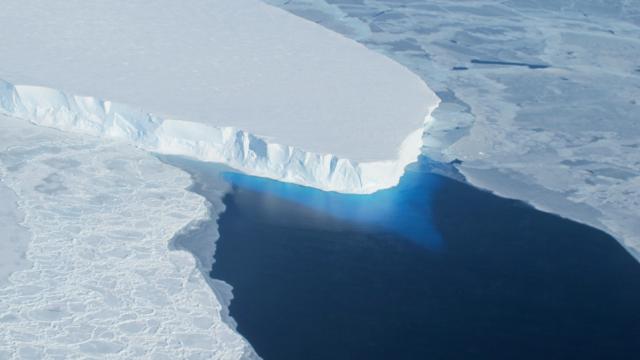Antarctica is the font of bad news that just keeps on giving. Thwaites Glacier, among the most threatened hunks of ice on the continent, is in even more dire straits than previously reported. Its melt from above and below is being aided by newly discovered cavities below the ice, as chronicled in Science Advances on Wednesday.
The gaping hole in the ice has a footprint two-thirds the size of Manhattan and is tall enough to fit the Statue of Liberty three times over. In other words, no dentist is fixing this. Instead, it could potentially spell doom for not just Manhattan but other coastal areas by speeding along the destruction of Thwaites, pushing more land ice into the sea.
Thwaites Glacier is located in West Antarctica, an area that is facing what could be runaway melt owing to geography and inescapable heat. The bedrock under Thwaites and other glaciers in the region slopes downward further inland, allowing that warm water to rot out the glaciers from underneath. The region is the fastest melting part of Antarctica, and losing the land ice could lead to more than 3.05m of sea level rise.
The discovery of cavity beneath Thwaites Glacier along with a number of other disconcerting features offer a new wrinkle to the harrowing tale of West Antarctica. Scientists used a combination of ice-penetrating radar flown on NASA planes and European satellite data to capture what’s going on. The measurements resolve fine-scale details of what happens where the ice meets the bedrock. Or, it turns out more accurately, where the ice doesn’t meet the bedrock.
The data revealed yawning caverns under the ice, the biggest of which is the aforementioned half-Manhattan sized gap. That cavity is big enough to hold 14 billion tons of ice or 5.6 million Olympic-sized swimming pools. Instead, it’s allowing warm water to get up under the glacier and speed along its retreat. Oh, and it could be growing.
“[The size of] a cavity under a glacier plays an important role in melting,” said the study’s lead author, Pietro Milillo, a scientist at NASA Jet Propulsion Laboratory who led the study, said in a press release. “As more heat and water get under the glacier, it melts faster.”
The glacier isn’t retreating uniformly. The fastest retreat of floating ice is about a half mile a year with various areas thinning at up to 650 feet per year. The findings also show that the grounding line — where the ice meets the bedrock — migrates over a much larger scale than previously thought due to tidal mixing, and includes channels under parts of the ice that give warm water greater access to the interior part of the glacier. Ditto for the monster cavity.
These are all important factors that aren’t included in how researchers model ice shelves and glaciers and could lead to an even quicker retreat and faster sea level rise. Suddenly that wild Antarctic wall idea isn’t looking so outlandish.
